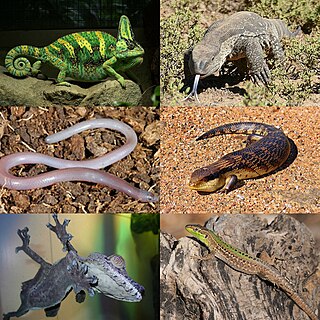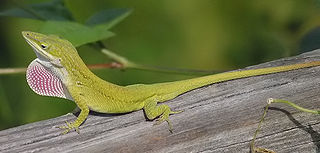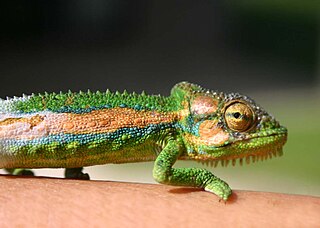
Lizard is the common name used for all squamate reptiles other than snakes, encompassing over 7,000 species, ranging across all continents except Antarctica, as well as most oceanic island chains. The grouping is paraphyletic as some lizards are more closely related to snakes than they are to other lizards. Lizards range in size from chameleons and geckos a few centimeters long to the 3-meter-long Komodo dragon.

Chameleons or chamaeleons are a distinctive and highly specialized clade of Old World lizards with 200 species described as of June 2015. The members of this family are best known for their distinct range of colours, being capable of colour-shifting camouflage. The large number of species in the family exhibit considerable variability in their capacity to change colour. For some, it is more of a shift of brightness ; for others, a plethora of colour-combinations can be seen.

Dactyloidae are a family of lizards commonly known as anoles and native to warmer parts of the Americas, ranging from southeastern United States to Paraguay. Instead of treating it as a family, some authorities prefer to treat it as a subfamily, Dactyloinae, of the family Iguanidae. In the past they were included in the family Polychrotidae together with Polychrus, but the latter genus is not closely related to the true anoles.

The central bearded dragon, also known as the inland bearded dragon, is a species of agamid lizard found in a wide range of arid to semiarid regions of eastern and central Australia.

Anolis carolinensis or green anole is a tree-dwelling species of anole lizard native to the southeastern United States and introduced to islands in the Pacific and Caribbean. A small to medium-sized lizard, the green anole is a trunk-crown ecomorph and can change its color to several shades from brown to green.

The leopard gecko or common leopard gecko is a ground-dwelling gecko native to the rocky dry grassland and desert regions of Afghanistan, Iran, Pakistan, India, and Nepal. The leopard gecko is a popular pet, and due to extensive captive breeding it is sometimes referred to as the first domesticated species of lizard.

The veiled chameleon is a species of chameleon native to the Arabian Peninsula in Yemen and Saudi Arabia. Other common names include cone-head chameleon, Yemen chameleon, and Yemeni chameleon. They are born pastel green and without their distinctive casques on their head.

The common basilisk is a species of lizard in the family Corytophanidae. The species is endemic to Central America and South America, where it is found near rivers and streams in rainforests. It is also known as the Jesus Christ lizard, Jesus lizard, South American Jesus lizard, or lagarto de Jesus Cristo for its ability to run on the surface of water.

Jackson's chameleon, also known commonly as Jackson's horned chameleon, the three-horned chameleon, and the Kikuyu three-horned chameleon, is a species of chameleon, a lizard in the family Chamaeleonidae. The species is native to East Africa, and introduced to Hawaii, Florida, and California. There are three recognized subspecies.

The Namaqua chameleon is a ground-living lizard found in the western desert regions of Namibia, South Africa and southern Angola.

The Cape dwarf chameleon is a chameleon native to the South African province of the Western Cape, where it is restricted to the region around Cape Town.

Varanus timorensis, the Timor monitor or spotted tree monitor, is a species of small monitor lizards native to the island of Timor and some adjacent islands.

The common chameleon or Mediterranean chameleon is a species of chameleon native to the Mediterranean Basin and parts surrounding the Red Sea. It is the only extant species of Chamaleonidae with a range that naturally extends into Europe.

The San Esteban chuckwalla, also known as the piebald chuckwalla or pinto chuckwalla, is a species of chuckwalla belonging to the family Iguanidae endemic to San Esteban Island in the Gulf of California. It is the largest of the five species of chuckwallas, and the most threatened.

Anolis cristatellus is a small species of anole, belonging to the Dactyloidae family of reptiles. The species is native to Puerto Rico and the U.S. and British Virgin Islands, with introduced populations in locations around the Caribbean. The males of A. cristatellus are easily recognizable by the fin running down the top of the tail, which is known as a "caudal crest". The females also have this crest, but it is smaller than that of the males. The species is often quite common in many areas on Puerto Rico, where it can be seen during the day passing the time on the lower parts of tree trunks, or on fences and the walls of buildings in urban areas, sometimes venturing down onto the ground in order to lay eggs, have a snack, or do other cursorial activities. Like many anoles, this species displays the characteristic behaviour of doing push-ups as well as inflating a pizza-like flap of coloured skin on its throat, known as a dewlap, in order to show others how dominant it is, and thus attract mates or intimidate rivals.

The southern rock agama or southern African rock agama is a species of lizard from the family Agamidae that occurs in Southern Africa in Zambia, South Africa, Eswatini, Mozambique, Zimbabwe and Botswana. It lives in small colonies on rocky outcrops, and the males are very conspicuous for their bright blue heads.

Uracentron flaviceps, the tropical thornytail iguana or Amazon thornytail iguana is an elusive species of medium-sized arboreal lizard found in the tropical lowlands of the Amazon Rainforest. The species was described by French zoologist Alphone Guichenot in 1855. They are considered to be ant specialists and exhibit communal nesting and a harem-style breeding system in which one male mates with and attends to multiple females. Study of this species has been impeded by difficulties collecting and observing them.

Microlophus albemarlensis, the Galápagos Lava lizard, also known as the Albemarle Lava lizard, is a species of Lava lizard. It is endemic to the Galápagos Islands, where it occurs on several islands in the western archipelago: the large islands Isabela, Santa Cruz, Fernandina, Santiago and Santa Fe, as well as several smaller islands: Seymour, Baltra, Plaza Sur, Daphne Major and Rábida. It is the most widespread of the Galápagos species of Microlophus, the others only occurring on single islands. Some authors however, consider populations on Santiago, Santa Cruz, and Santa Fe to be distinct species. The species is commonly attributed to the genus Microlophus but has been historically placed in the genus Tropidurus.

Anolis grahami, commonly known as the Jamaican turquoise anole and Graham's anole, is a species of lizard in the family Dactyloidae. The species is native to the island of Jamaica, and has also been introduced to the territory of Bermuda. It is one of many different species of anole lizards found in Jamaica. There are two recognized subspecies.

Plica plica is a species of lizard in the family Tropiduridae, the Neotropical ground lizards. Its common names include collared tree lizard, collared tree runner,tree runner, and harlequin racerunner. In Guyana it is known as wakanama.





















